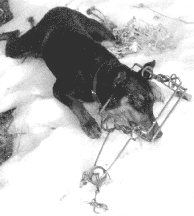

Trapping |
||||||
| Hunters use many cruel traps to capture their victims of fashion. | ||||||
|
 |
|||||
|
 |
|||||
|
||||||
Most states require the traps to be checked every twenty-four hours. Montana, Nevada, Oregon, South Dakota, Utah, Washington, and Wyoming allow the traps to go two or three days without checking. Michigan, North Dakota, Alabama, Alaska, and Kansas actually have no trap-check requirements meaning that an animal can suffer for weeks before the hunter returns. When they do return, most hunters skin the animal right there and leave the carcass to nature. In some states, it is illegal to disturb a trap even if it is to release a trapped dog or cat. |
||||||
The animals that are accidentally stuck in a trap but are not used for fur coats are referred to as “trash animals”. These animals are the nontarget animals such as dogs, cats, rabbits, deer, songbirds, owls, livestock, and even endangered species. A former professional trapper said, “At least two nontarget animals are trapped for each target animal.” These animals usually are thrown away, hence the name trash. Most trappers usually kill the animal if it still alive, remove the body, and leave it for nature. In some cases, neighborhood dogs and cats walk through the trap or sniff it and they set it off. The Humane Society of the United States reported finding a Doberman that suffered 18 hours with a trap shut around her neck until she suffocated.
|
||||||
| IT'S LEGAL TO SET TRAPS AROUND NEIGHBORHOODS AND SCHOOLS!! | ||||||